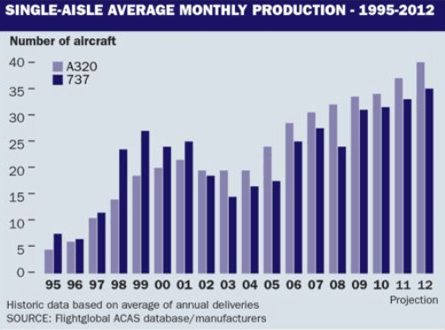Airbus and Boeing are underlining their confidence that the airline traffic recovery is back to stay as well as their intent to tackle any potential threats to their single-aisle families with tit-for-tat output hikes.
Airbus has made the latest move, announcing that A320-family output will be increased in phases from the current 34 a month - already an industry record for jet airliner production - to 40 within 18 months. It had previously said A320 production was increasing to 36 a month in December, but it says that the upturn in the market means that the push will continue, with 38 reached in August next year and 40 in early 2012. The bulk of these will be assembled at Airbus's European sites, although four units a month will be built at the Chinese plant in Tianjin for the local market.
The "increased demand" for the twinjet - confirmed by a series of new orders at Farnborough - combined with its "healthy" backlog of more than 2,200 aircraft, has prompted the production decision, says Tom Williams, Airbus's executive vice-president for programmes.
Richard Aboulafia, vice president analysis at Teal Group, believes that the airframers are gambling that airline traffic will continue to outperform the rest of the world economy, but warns that if the growth diminishes in line with the economy "we'll be in an overcapacity situation".
 |
|---|
Williams and his colleagues have made no secret of Airbus's desire to kill off new narrowbody entrants such as the Bombardier CSeries and Comac C919 before they can establish themselves, and observers see these production hikes as part of the strategy to achieve this.
In May, Williams stated Airbus's intention to ensure that there is "no business case left" for the new Bombardier twinjet when it arrives in 2013, which is one of the motivations behind its A320 New Engine Option study.
"Flooding the market is a great way to fend off competition, or the threat of change," says Aboulafia.
In Seattle, Boeing 737 output is rising from 31.5 a month, with the current plan - announced in June - for it to reach 35 in 2012.
This would be the highest monthly rate ever for the Boeing twinjet, but speaking at Farnborough last month, Boeing Commercial Airplanes boss Jim Albaugh hinted that even higher output was needed to counter threats. He said that his "one worry" was that production may not reach the required level "to give people the airplanes we could drive customers to go and buy the CSeries".
Further 737 increases hinge on supply-chain capacity, says Boeing's chief executive Jim McNerney, with a decision expected by late September or October.
While market studies have made it clear there is "some upside" to increasing the production rate beyond 35, "the supply chain is the key question", says McNerney. "We have better clarity on the market right now than the supply chain's capability to go higher than they've already committed."
McNerney notes that many 737 suppliers are also ramping up output for the increasing A320 rate, as well as supporting the new narrowbody types like the CSeries and C919.
"If the supply chain is committed and capable [of building more 737s] you will see further movement," McNerney says.
Boeing's analysts are working through a number of scenarios. Some suppliers need to invest in tooling or facilities, others need more training for employees, and some require new contracts with Boeing to go beyond 35 737s a month, McNerney says.
Source: Flight International























